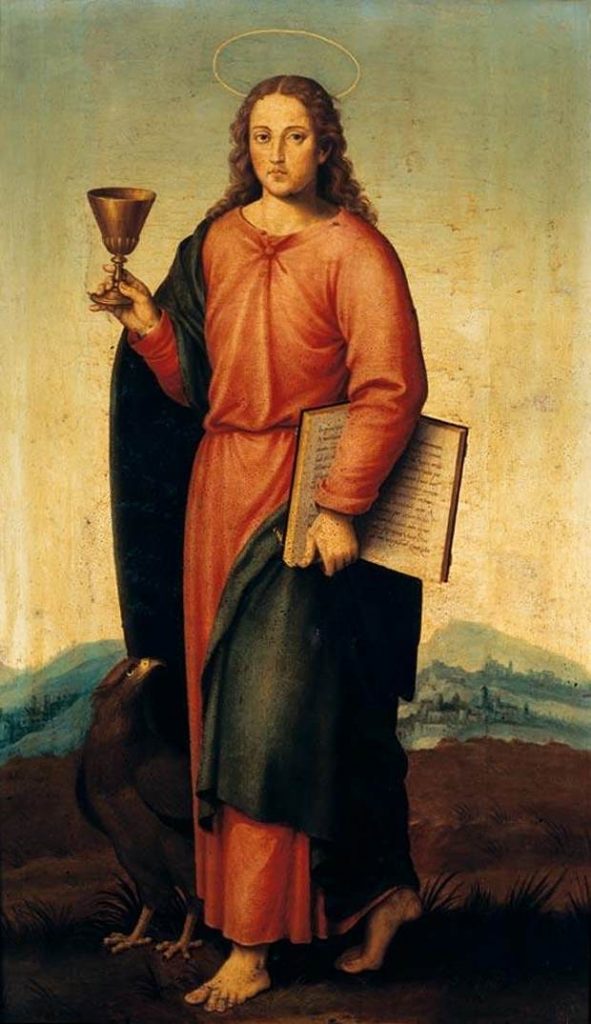For years I have toyed with using St John as the December saint because his feast day is so close to Christmas but have been put off because although he is one of the Apostles and the author of a Gospel, and also the Book of Revelations and an epistle we have very few hard and fast facts about him.

From the gospels we know that he was the brother of St James and that they were fishermen and the sons of Zebedee and that Jesus called them to follow him, and they left their father’s fishing boat to become disciples of Our Lord. We also know from the Gospels that Jesus referred to the two brothers as being Boanerges, or Sons of Thunder. It is not known why they were given this nickname. It has been suggested that it may have been that they were fairly positive characters instanced in their urging Jesus to bring fire down on the Samaritan villages that refused to accept His teaching which earned a rebuke from Our Lord which is mentioned in both the Gospels of Mark and Luke.
Along with St Peter the two brothers seem to have become an inner core of the Apostles especially close to Jesus. They travelled with Jesus and were there at all the important occasions of His ministry. They were at the transfiguration of Our Lord and they journeyed with him on his last journey to Jerusalem. There are one or two references to James and therefore also John as being brothers of Jesus, which is taken as being close relatives not actual brothers. They travelled with Jesus on his last journey to return to Jerusalem. Indeed it was John that Jesus sent to make ready the room for the last supper. They seem to have decided that they were entitled to sit one on each side of Jesus and asked Jesus make it so when he should he should come into his kingdom. This is mentioned in the Gospels of Matthew, Mark and Luke and is virtually the same except that in Matthew it is their Mother the wife of Zebedee who asks for this honour for her two sons. Jesus rebukes them again saying that this privilege was not His to give but God the Father’s. We also know from the Bible in Acts that John played an important part in the Councils of the Apostles and meets with the Apostles for prayers and he accompanied St Peter when the latter appeared before the Court at the Temple and confounded the High Priest and the Jewish authorities by curing an gravely sick man in the name of Jesus.
So much for the references to John in the New Testament but what else do we know of him that is reasonably reliable. Firstly and mainly he is attributed as being the author of the Gospel According to St John, of the Book of Revelations, and of three Letters. The early church had no doubt that he was the author of all of these but over the years biblical scholars have cast doubts as to the authorship. There seems to be little doubt that that they emanated from John but the actual writing may have been ghosted by another writer or writers. This is partially based on their being written in the third person and not actually naming John but referring to him as the “ Beloved Disciple”. Equally well it may just have been that John through modesty did not want to boast of his closeness to Jesus. Although in some instances James (and ergo John) are referred to as being the brothers of Jesus having different parents they could not have been siblings but the word brother was used in Aramaic to indicate any close male relative. John was therefore probably a younger cousin of Jesus. If we accept that as being the case we learn something more from St John’s Gospel about him. St John’s Gospel is the only one that mentions the wedding feast at Cana and he goes into a lot of detail on it. This would indicate that John was there, though not the bridegroom as some believed. Since the wedding was a family occasion this supports the hypothesis that John was related to Jesus. Secondly in the Passion according to St John Jesus on the Cross commends Mary his mother to St John if John is indeed identified as the “beloved disciple”.
This leaves us to consider what happened to St John in the years after the death of Jesus. The early church was rife with speculation about all the Apostles as it seemed that every Christian community wanted to be involved and they all wanted to claim connections with the Apostles. St John was no exception and an apocryphal work known as the Acts of St. John was doing the rounds in the second and third centuries alleging that John had preached the Gospel in North Africa and had been condemned to death by being thrown into boiling oil which he had miraculously survived. He then went on to the Island of Patmos where he did his writing and then did not die but ascended to heaven.
The above would appear to be partially true for tradition has it that St John was the only Apostle that was not martyred but after preaching the gospel in region of Ephesus he was exiled to Patmos where he died from natural causes in his nineties.
His relics were interred in a shrine at Ephesus, or rather there were two shrines at Ephesus that claimed to be the true resting place of the saint. One of the claims was withdrawn in the 4th Century just leaving one. There was a superstition that dust from the shrine had miraculous curative powers.
As St John was not a martyr he is the only Apostle whose feast day is an occasion for white vestments rather than red.
His feast day in the Western Church is 27th December and in the Eastern Orthodox Church he has two feast days the 8th May and 26th September

